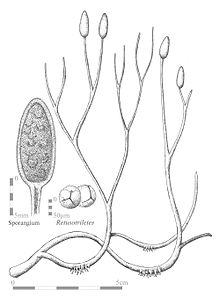Aglaophyton
| Aglaophyton Temporal range:
| |
|---|---|

| |
| Reconstruction of the sporophyte of Aglaophyton, illustrating bifurcating axes with terminal sporangia, and rhizoids. Insets show a cross-section of a sporangium and the probable spores. | |
| Scientific classification | |
| Kingdom: | Plantae |
| Clade: | Polysporangiophytes |
| Genus: | †Aglaophyton D.S.Edwards 1986[1] |
| Species | |
| |
| Synonyms | |
| |
Aglaophyton major (or more correctly Aglaophyton majus
A. major was first described by Kidston and Lang in 1920 as the new species Rhynia major.
Description

The stems of Aglaophyton were round in cross-section, smooth, unornamented, and up to about 6mm in diameter. Kidston and Lang[3] interpreted the plant as growing upright, to about 50 cm in height, but Edwards[1] has re-interpreted it as having prostrate habit, with shorter aerial axes of about 15 cm height. The axes branched dichotomously, the aerial axes branching at a comparatively wide angle of up to 90°, and were terminated with elliptical, thick-walled sporangia, which when mature, opened by spiral slits, so that the sporangia appear to be spiral in form.[4] Sporangia contained many identical spores (isospores) bearing trilete marks. The spores may therefore be interpreted as meiospores, the product of meiotic divisions, and thus the plants described by Edwards and by Kidston and Lang were diploid, sporophytes. The plant was originally interpreted as a tracheophyte, because the stem has a simple central vascular cylinder or protostele,[3] but more recent interpretations in the light of additional data indicated that Rhynia major had water-conducting tissue lacking the secondary thickening bars seen in the xylem of Rhynia gwynne-vaughanii, more like the water-conducting system (hydrome) of moss sporophytes. Edwards[1] reinterpreted the species as non-vascular plant and renamed it Aglaophyton major.
Aglaophyton is among the first plants known to have had a mycorrhizal relationship with fungi,[5] which formed arbuscules in a well-defined zone in the cortex of its stems. Aglaophyton lacked roots, and like other rootless land plants of the Silurian and early Devonian may have relied on mycorrhizal fungi for acquisition of water and nutrients from the soil.
The male
Taxonomy
Aglaophyton major was first described as Rhynia major by Kidston and Lang in 1920.[3] In 1986 D.S. Edwards re-examined fossil specimens and reported that they did not contain true vascular tissue, but rather conducting tissue more similar to that of bryophytes. As the diagnosis of Rhynia was that it was a vascular plant, he created a new genus, Aglaophyton, for this species. (The other species of Rhynia, R. gwynne-vaughanii, was not affected.) As Rhynia major the species had been placed in the rhyniophytes, but no alternative higher level classification was proposed for the new genus.[1]
Phylogeny
In 2004, Crane et al. published a
| polysporangiophytes |
| ||||||||||||
